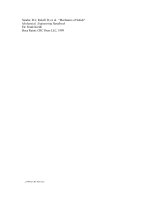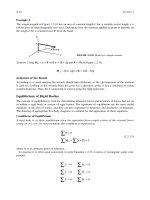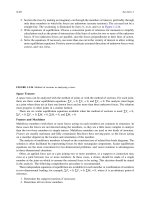CRC Press - Mechanical Engineering Handbook- Mechanics Of Solids Part 9 pps
Bạn đang xem bản rút gọn của tài liệu. Xem và tải ngay bản đầy đủ của tài liệu tại đây (34.42 KB, 1 trang )
1-80 Section 1
Shear Stresses in Beams
Transverse loads on beams are common, and they cause transverse and complementary longitudinal
shear stresses in the beams. Schematically, the transverse shear stresses are distributed on a rectangular
cross section as shown in Figure 1.5.20. The shear stress is zero at free surfaces by definition.
The internal shear stress is calculated according to Figure 1.5.20 from
(1.5.30)
where τ = shear stress value at any point on the line ᐉ – ᐉ at a distance y
′
from the neutral axis
V = total shear force on cross-sectional area A
Q = A
′
= area above line ᐉ – ᐉ; = distance from neutral axis to centroid of A
′
I = moment of inertia of entire area A about neutral axis
t = width of cross section where τ is to be determined
This shear formula gives τ
max
= 1.5 V/A if t is constant for the whole section (rectangle).
Note that the magnitude of the shear stress distribution changes sharply where there is an abrupt
change in width t, such as in an I-beam, Figure 1.5.21.
Shear Flow
In the analysis of built-up members, such as welded, bolted, nailed, or glued box beams and channels,
a useful quantity is the shear flow q measured in force per unit length along the beam,
(1.5.31)
FIGURE 1.5.20Transverse shear stress distribution.
FIGURE 1.5.21Shear stress distribution for I-beam.
τ=
VQ
It
′′
yA;
′
y
q
VQ
I
=









